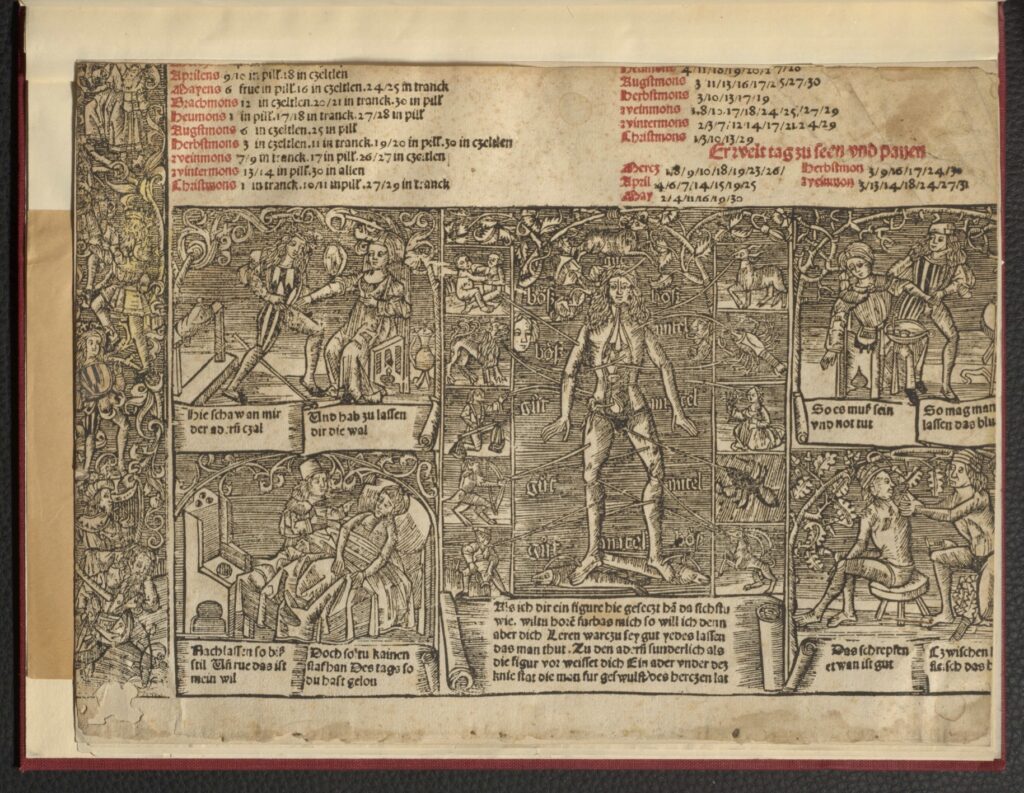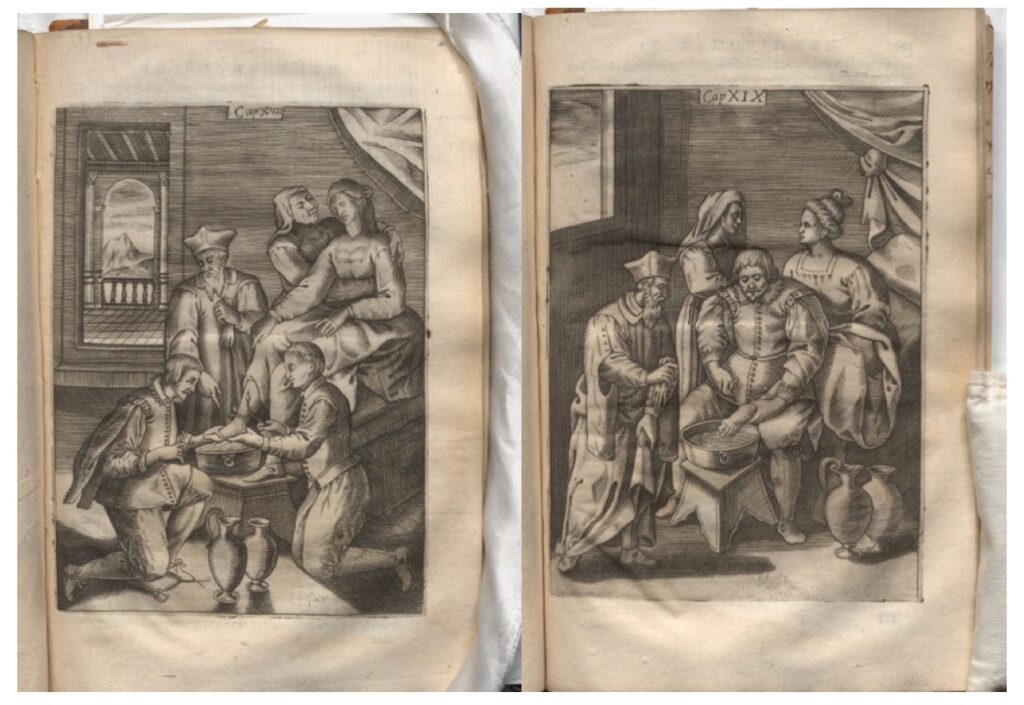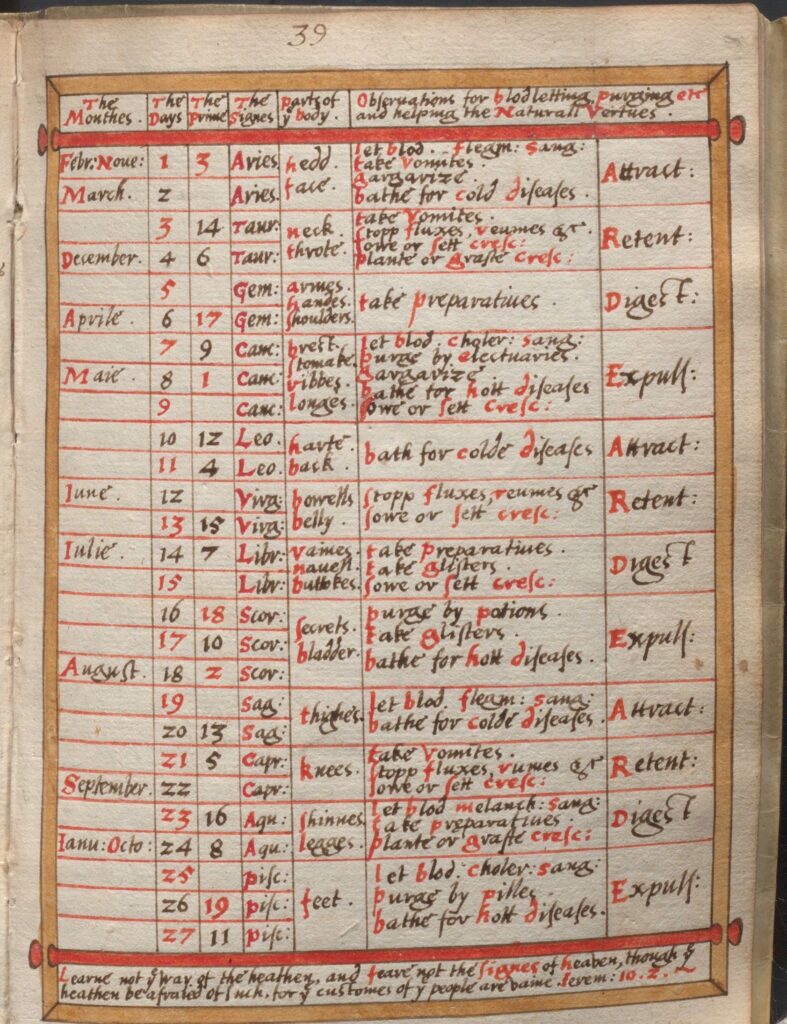This piece is inspired by research done as a Folger Fellow, some of which is summarised in a blog post entitled “Balancing information and expertise: vernacular guidance on bloodletting in early modern calendars and almanacs,” published in The Collation: Research and Exploration at the Folger, Folger Shakespeare Library, 9 February 2021.

A little over a year ago, I came across an intriguing early printed almanac. Described simply as “[Calendar for Austria, 1496],”[1] the single printed page is secured in a red binding. A central prominent woodcut of a zodiac man leaves little doubt that the purpose of the calendar was to guide those who might need be bled for preventative or curative purposes.
The zodiac man (or Aderlaßmann, as this type of character would be known in German) has lines carved from approximated veins – each of which corresponds to an astrological sign – to one of three words: güt, mitel, böß, suggesting when in the year it was good, okay, or dangerous to bleed. The Aderlaßmann is surrounded by four other health-related woodcuts. Of these, two depict a female being bled: one from the right arm, the other from the left. The accompanying text, however, refers only to the benefits of bloodletting and says nothing specifically about women. In one piece of writing, I suggested rather flippantly that the women might have been included due to their commercial appeal.[2] That is, perhaps these images would have drawn the attention of potential buyers for what we believe was a much larger almanac and calendar.
A more serious question might be: does there have to be a reason for a female to be shown? What if there were no unspoken motivation behind the images? After all, although blood itself was often written about in highly gendered terms,[3] general rules for bloodletting tended to ignore sex altogether.[4] My questions were not only about the choices made by the original artist(s) involved in the production of the calendar; I also wondered about the original cataloguing, and why the description mentions the two bloodletting scenes, but not the unusual fact that they featured women.
My questions about the women in the calendar’s woodcuts brought me on another journey. I started to investigate whether there were other sources where women were shown being bled, but where the accompanying text bore no mention of treatment specific to females. The results of an unscientific analysis are incomplete and inconclusive. It does seem, however, that in printed books the images of women do tend to correlate to text that is specific to female complaints; or, at the very least, the text mentions women.
Sticking to local examples, Pietro Paolo Magni’s Discorsi de sanguinare, first printed in 1586, includes two woodcuts of a female being bled, each of which correlates directly to a chapter where the opening lines refer to female complaints as reasons for therapeutic bloodletting.

Returning to the question of cataloguing and thus to the subject of discovery, it is worth noting that anyone wishing to study images of women being bled will need to dig since few such images are identified. This is understandable. The information that can go into a catalogue record is limited and this sort of search is highly specific. It is the job of scholars (and the librarians who help them) to know enough about the types of material that are likely to be fruitful, that one can call up a work even if there is no mention in the catalogue record of the specific topic of interest.
It was in this way that another work in the Osler Library – this one with no images of people, but full of calendars and other diagrams – came to light as an excellent source for bloodletting history. Knowing that almanacs and calendars often prescribe when to bleed, I decided to check William Mount’s 1583 manuscript, “A shorte declaration of the meaning and use of a perpetuall calendare or almanack.” What it had to offer was truly remarkable: detailed instructions in a clear hand, outlining precisely how to interpret and use each table or diagram, including one section linked to a chart provided to determine the best time to bleed or undergo other evacuative remedies. Even within the text, the table that relates to bloodletting does not identify itself as such. Rather, it has the title “The table of the moones place in the 12 signes.” The reason for knowing the moon’s place within each astrological sign, however, was to know when it was safe (or perilous) to bleed. As Mount notes in his instructions, “then shall you see directlie from that place forward the right hand, the Signe where the Moone is that daie, what part of the body is governed thereby, whether it be the fittest tyme to let blood, to purge, to bathe, to sowe, sett, plant &c or to comfort any of the naturall vertewes.”[5]

Though new sources have come to light on the course of this tiny bloodletting journey, the larger point is not new: cataloguing and description provide a portal, but librarians and scholars alike rely upon intellectual creativity to tease out new sources to support research questions. Sometimes we talk of serendipity when we come upon something entirely unexpected and important, but more often our discoveries are the result of intelligent research.
[1] [Calendar for Austria, 1496], [Nuremberg?]: Kaspar Hochfeder, 1495. (Catalogue record here.)
[2] Mary Yearl, “Bloody women,” Hektoen International, Winter 2020.
[3] Peggy McCracken, The Curse of Eve, the Wound of the Hero: Blood, Gender, and Medieval Literature, The Middle Ages Series (Philadelphia: University of Pennsylvania Press, 2003).
[4] M.K.K. Yearl, “Monastic customaries on minuti and infirmi,” in Barbara S. Bowers, ed., The Medieval Hospital and Medical Practice, Avista Studies in the History of Medieval Technology, Science and Art, Volume 3 (London: Routledge, 2016; originally published Ashgate, 2007).
[5] William Mount, A shorte declaration of the meaning and use of a perpetuall calendare or almanack, 1583, B.O. 7601, Osler Library of the History of Medicine. (Catalogue record here). A full transcription of the passage describing how to use the bloodletting table is linked in Mary Yearl, “Balancing information and expertise: vernacular guidance on bloodletting in early modern calendars and almanacs.”













Leave a Reply
You must be logged in to post a comment.